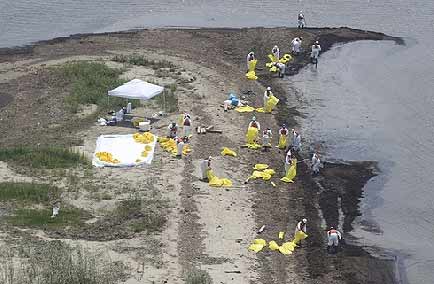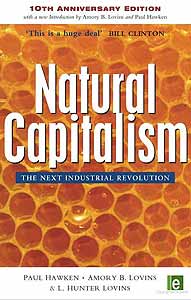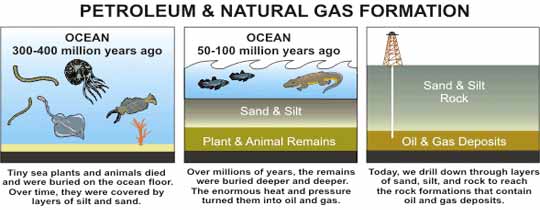Biblio
A leading congressional critic of shale drilling is scolding the Obama administration for failing to try to slow drilling in the Northeast's Marcellus Shale.
Rep. Maurice Hinchey (D-N.Y.) fired off a letter (pdf) yesterday to the commander of the North Atlantic Division of the Army Corps of Engineers, Brig. Gen. Peter "Duke" DeLuca. DeLuca represents the federal government on the little-known but powerful Delaware River Basin Commission (DRBC), and he rebuffed Hinchey's request that he use his vote to block gas drilling there until a lengthy study is completed.
See: Keystone XL Pipeline - Issues
Both Hinchey and Johanns have been rebuffed by the President and the State Department. Might this be telling us about the direction the Administration is taking in regards to its Energy Policy? nz
See: Obama Admin Rejects Timeout for Natural Gas Drilling in N.Y., Pa.
See: What President Obama should have said about natural gas.
See: In Pa., Rove tells Marcellus shale drillers: Expect 'sensible regulation'
On May 22, 2010 President Obama established the National Commission on the BP Deepwater Horizon Oil Spill and Offshore Drilling through Executive Order 13543 issued on May 21, 2010.
Presentation of the findings and recommendations in the National Oil Spill Commission’s final report on the causes of BP’s Gulf rig blowout and prevention of future disasters will be held 11am EST, Tues., Jan 11, 2011 at the The National Press Club: 529 14 St., NW, Washington DC.
Viewing: Credentialed press only. Public viewing available via live stream at www.OilSpillCommission.gov.
See: The Ceres Principles | Mixplex
See: Before the Big Spill | Mixplex
See: BP Deepwater Horizon Committee Hears From Oil Industry Executives | Mixplex
Kurt Repanshek. November 5, 2008. National Parks Traveller.
These and other slices of the public lands landscape deserve some form of protection for visitors today and tomorrow to enjoy. And yet, the outgoing Bush administration is determined to open them to drilling rigs with all their associated access roads, noise, air, and, potentially, water pollution.
How much is too much? When the oil and gas industry in Utah has nearly 3,500 drilling permits in hand, but which have not been acted upon, why is the Bush administration selling them more, particularly in sensitive areas around national parks and monuments?
Conservation groups such as the National Parks Conservation Association, The Wilderness Society, and the Southern Utah Wilderness Alliance warned that the BLM was poised to announce on Election Day that it was ready to sell hundreds of oil and gas drilling leases in the above-cited places as well on lands surrounding Dinosaur National Monument, Arches National Park, and Canyonlands National Park.
But when Election Day arrived, BLM officials merely announced they were opening 360,000 acres to oil and gas work without specifying exactly where those leases would fall.
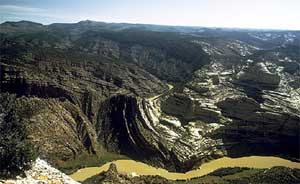
See: Environment News Service (ENS). Bush-Era Oil and Gas Leases Near Utah Parks Canceled. 2/4/2009.
See: Deseret News. Geoff Liesik and Mary Bernard. "Judge says drilling lease lawsuit too late". Salt Lake City. 9/2/2010.
See:Earthworks: 4/1/2010 "Obama's gifts to extractive industries continue with defense of Bush mining policy".
See: Student Disrupts Government Auction of 150,000 Acres Of Wilderness For Oil & Gas Drilling.
Hawken (The Ecology of Commerce) and Amory and Hunter Lovins of the Rocky Mountain Institute, an environmental think tank, have put together an ambitious, visionary monster of a book advocating "natural capitalism."
The short answer to the logical question (What is natural capitalism?) is that it is a way of thinking that seeks to apply market principles to all sources of material value, most importantly natural resources. The authors have two related goals: first, to show the vast array of ecologically smart options available to businesses; second, to argue that it is possible for society and industry to adopt them.
--Publishers Weekly
See: Paul Hawken. "Natural Capitalism | We can create new jobs, restore our environment, and promote social stability. The solutions are creative, practical, and profitable." Mother Jones. Mar/Apr97.
Natural Gas Informational Site by the U.S. Department of Energy (U.S. DOE). Includes articles on How Do We Get Natural Gas?, How Was Natural Gas Formed? Also article on Energy Explained, Use of Natural Gas, Delivery and Storage of Natural Gas, How Much Natural Gas Is Left.
The Independent Petroleum Association of America sent a letter (pdf) to EPA today highlighting two critics on the list of 82 potential panelists.
"Unfortunately, a number of nominees' past comments betray a strong and unambiguous antipathy toward shale development in general, and hydraulic fracturing in particular," IPAA President and CEO Barry Russell wrote.
The letter singles out two critics -- Theo Colborn and Robert Howarth. It does not give their names, but IPAA's detailed complaints about the two identify them.
Colborn is a Colorado zoologist and pharmacist whose group, TEDX — The Endocrine Disruption Exchange, has sought to document the damage that fracturing can do to water and human health. IPAA said she authored a "white paper" that called for federal regulation of fracturing.
Howarth is a Cornell University professor who issued a three-page draft report in April saying that shale gas production and use may generate as much greenhouse gas emissions as production and use of coal. Russell's letter said it was "riddled with errors."
See: U.S. EPA Initiates Hydraulic Fracturing Study | Meeting | EPA Science Advisory Board (SAB)
See: 2011 EPA Hydraulic Fracturing Study Plan Review Panel Selections.
See: Cornell’s Howarth Warns EPA on Shale Gas Greenhouse Footprint

Joanne Fiorito, acting as the eyes of the DEP, recently discovered a waste spill at a drilling site just off RT 29 and upon reporting the spill was warned not to trespass.
"If the DEP can't monitor these sites on their own," said Ms.Joanne Fiorito "and then the DEP tells us that we cannot trespass after we found a spill on the Grimsley well pad site that wasn't reported to the DEP by Cabot, well then, where does this leave the citizens of PA who are dependent on the DEP doing its job?
It has gotten to the point where I and others will have to do it ourselves, and I personally don't care if they arrest me for civil disobedience, because this land, air and water is what keeps us all alive."
People Feel Threatened
Chesapeake Energy reports that citizens in Wetzel County, West Virginia have placed spikes along RT 89.
Pittsburgh Post Gazette reports that 161 species found killed along 38 miles of Dunkard Creek -- "Sudden death of ecosystem ravages long creek 'Everything is being killed': 161 aquatic species have died along Dunkard Creek" by Don Hopey, Pittsburgh Post-Gazette; September 20, 2009.
Series: Buried Secrets: Gas Drilling's Environmental Threat.
Drilling companies assert that the destructive forces unleashed by the fracturing process, including the sometimes toxic chemicals that keep the liquid flowing, remain safely sealed as much as a mile or more beneath the earth, far below drinking water sources and the rest of the natural environment.
More than a year of investigation by ProPublica, however, shows that the issues are far less settled than the industry contends, and that hidden environmental costs could cut deeply into the anticipated benefits.
The technique used to extract the gas, known as hydraulic fracturing, has not received the same scientific scrutiny as the processes used for many other energy sources.
Update
See: Christopher Caskey. "Rally planned against gas well water in Auburn." The Citizen. 2011-05-26.
See: Scott Rapp. "Auburn group hopes protest sways city to stop taking wastewater from natural gas drilling." The Post-Standard. 2011-05-29.
See: Editorial. "Our View: Moratorium, study needed on wastewater." The Citizen. 2011-05-29.
Email correspondence between William M. Foster, Auburn, NY and Fracking Resource Guide. The public notice published in the Auburn Citizen on April 1, 2011 follows at the end of this post.
Hi Bill,
I saw your letter in the 5/17 Auburn Citizen and the group letter that had several signatories including Margaret Foster. I wanted to post these letters to Fracking Resource Guide, with you as the author. I looked for a picture of you online and couldn't find one. I also looked for pictures of the plant.
Here: http://ci.auburn.ny.us/Public_Documents/AuburnNY_Utilities/pollution
There are pictures of closups of various sump pumps, etc. not necessarily yours in Auburn here:
http://www.jwce.com/tag/economic/
Do you know where I can find or take a picture of the Auburn facility in close-up?
Here is what I found on the type of plant by Koester Industries. It's called a gravity thickener...
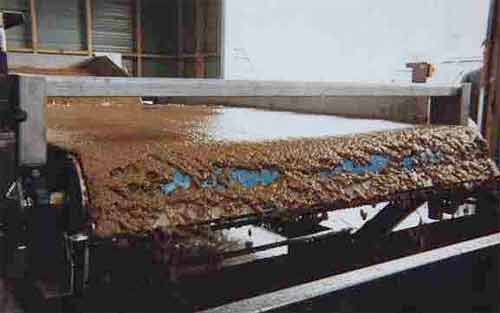
Here is my search:
If the link breaks in the mail, here is the search in short form:
If this does look like your plant, let me know.
Regards,
Neil
The email correspondence began with this:
william m foster sent a message using the contact form at http://frack.mixplex.com/contact. Dear Sirs - we are a recently formed group opposed to hydrofracking in the finger lakes - we would like to distribute a copy of your report to a number of organizations in cayuga county - would this be ok with you? Hello, The Marcellus Accountability Project (MAP) is here: http://www.tcgasmap.org/ It is run by Bill Podulka, an engineer at Cornell. My site does not have the authority to re-distribute original content - it serves as a digital library. I write annotations for many of the articles. You are welcome to print, email and/or link to any of the material in this collection, of which MAP is one of the articles. I try to present information that is accurate, useful and inspired in my choice of articles in the collection. The issues of hydrofracking go beyond the well sites and touch on larger environmental, health, and legal concerns. Since my mission is to curate and distribute, I welcome your inquiry and wish you Best Regards, Neil Zusman http://frack.mixplex.com
-----Original Message-----
From: Neil Zusman [mailto:info@frack.mixplex.com]
Sent: Monday, April 11, 2011 8:52 AM
To: morgan.foster@verizon.net
Subject: Re: [Info] marcellus accoutability project
On 4/11/11 11:01 AM, Morgan-Foster Agency wrote:
Dear Neil - thank you for responding to my request - I have contacted Mr. Podulka's group and hope he will give us a favorable reply. We came together after NY Times article indicating that Auburn's Treatment Plant "cleans" fracked water. We are going to next Thursday's 4:30 Auburn Council Meeting to try to put an end to this practice. Bill Foster
-----Original Message----- From: Neil Zusman [mailto:info@frack.mixplex.com] Sent: Monday, April 11, 2011 1:00 PM To: Morgan-Foster Agency Subject: Re: [Info] marcellus accoutability project Hello Bill, You might also wish to contact Water Hang of Toxics Targeting: http://www.toxicstargeting.com/contact_us Regards, Neil
Neil - thanks - my niece has e-mailed a letter Mr. Hang sent to Gov Cuomo concerning Auburn Plant. Will be an interesting Thursday. Bill Foster
Letter from Auburn citizens to the City of Auburn, N.Y.
We are here tonight to speak about the public notice and article that appeared in the March 31st edition of The Citizen. The public notice lists eight companies that failed to comply with the city's wastewater treatment plant regulations. Six of those companies are natural gas drilling firms. The notice states that for all of 2010, many of these natural gas companies failed to submit quarterly self-monitoring reports.
The city called their attention to it a year later. Within that time frame , the city took in over 16 million gallons of gas drilling wastewater.
The notice mentions that the companies submitted required certification that the drilling water did not come from hydraulic fracturing , or hydrofracking , in the Marcellus Shale .
Can we verify this? How do we know that this is the case apart from taking natural gas companies at their word? Is that all it is--a certificate submitted a year after the fact that the city's plant did not take a radioactive toxic mix that no wastewater treatment plant is equipped to handle?
We have little faith in the integrity of the natural gas industry.
According to a March 1 article in the New York times, in Pennsylvania natural gas drilling companies aren't even required to track what they dispose or where they dispose their wastewater. Chesapeake Energy, one of the companies listed in the public notice for failure to comply, is hydrofracking in Pennsylvania. We have watched as natural gas executives blatantly lied to a congressional committee that the chemicals used in hydrofracking are safe .
Chemicals like benzene, toluene, methanol, formaldehyde--known carcinogens and neurotoxins.
The natural gas industry says there is no evidence that hydrofracking has contaminated drinking water while people in Colorado, Wyoming, Pennsylvania and other states can now light their tap water on fire and suffer from severe health issues.
Bluntly put, the natural gas industry has no incentive to tell the truth. They are free from federal and state laws that protect public health and prevent hazardous materials from entering public water . These companies have been exempt from any responsibility to disclose what chemicals they use…
...We say no more.
Beth Cuddy, Terry Cuddy, Patty Beer, Bill Foster, Taylor Price, Theresa Walsh, Ann Foster, David Foster, Walt Aikman, Roger Beer, Teresa Foster, Devon Roblee, Andy Roblee, Laura Coburn, Steve Gamba, Brian Landers, Marisol Landers, Bodhi Landers, Amy Chamberlain, Jesse Reich, Peter Cramer, Diane Sauso, Chris Sauso, Dia Carabajal, Lee Ballard, Matthias Ballard, Vera Carabajal, Nate Vitale, Julie Vitale, Vanessa Carpenter, Nick Diego, Lisa Hoff, Beth Ann McCarthy, Jennifer Balyszak Herbert, Laurel Ullyette, Jennifer Kulis Starr, Dustin Orofino, Kelly L. Woodman, Don Miller, James Cantu, Jessica Cantu, Jesse Kline, Tom Yaglowski, Chuck Mason, Steve Kline, Rob Morphy, Carrie Gregg, Lois Brazak, Bradley Molloy, Jaeseena Bertot, Thomas Tracy, Matthew Smith, Joan House, Susan Marteney, Doug Ward, Renee Ward, Ian Connerly, Barbara Moody, Blaine Moody, Stephen Stomps, Steve Coleman, Judy Coleman, Rhonda Miller, Dean Aversa , Mike Trapani, Joe Librandi-Cowan, Penny Pitman, Mary Nellenback, Anne Mlod, Janah Autovino, David Autovino, Margaret Foster, Tracy Crandall Herman, Jim Van Arsdale, and Betsy Alexander,...
Truthout is a source of independent journalism focusing on under-covered issues and uncoventional thinking.
In papers everywhere we hear arguments such as the one that appeared recently in the Rochester (NY) Business Journal, in an article by economist Raymond J. Keating, under the heading "N.Y. is missing out on economic opportunity."
Keating wrote, "Environmentalists are claiming that hydraulic fracturing threatens groundwater supplies and are using anecdotal evidence to support their claims. Yet years of evidence have demonstrated that the fracking process is safe."
This is not just misleading; it's artful misuse of the language. Or, as my mother would have put it in her habitually blunt way, it's a lie...
...If they have nothing to hide, and there is no danger, why do they keep the ingredients of their toxic fracking stews a secret? Why does the public not know what's in them? How can Keating or anyone else claim it's "safe" if we don't know what they're using? Do we want New York to be the next Gulf? Do we want to just trust the drilling companies to do the right thing, as we seemed to trust BP to manage a spill without adverse consequences?
Furthermore, do New Yorkers want their beautiful state turned into an industrial zone, a la eastern Colorado, huge swaths of Wyoming, much of Texas and Louisiana, and West Virginia? Take a drive to Northeastern Pennsylvania and see what the countryside looks like just a few years after horizontal fracking began there.
Well over half of these United States are in peril from fracking. This is simply nuts. It's not a local or regional, but a national issue (international now, as big gas deposits have been located, and in some cases are already being developed, in Poland, Austria, Hungary, Sweden, Ukraine, the United Kingdom, in Canada, China, and India. (Japan and other countries are buying into gas-drilling rights in the USA and elsewhere.)
See: Global Gas Flaring Identification in Google Earth
See: World of Shale
See: France to Unlock “Dirty” Oil Under Paris With Texan Help
But how clean is natural gas, really?
The Wilderness Society just released the new science and policy brief Doing it Right: Ensuring Responsible Natural Gas Development on Our Public Lands to address the question: How clean is natural gas?
Unfortunately, as the brief reveals, natural gas is not the panacea that its promoters would have us believe. Consider these facts:
Natural gas is only 30 to 50 percent cleaner burning than coal.
Natural gas is still a fossil fuel and our current use of it contributes about 20 percent of U.S. greenhouse gas emissions.
The processing, infrastructure, and burning of natural gas releases methane, a greenhouse gas 30 times more potent than carbon dioxide in terms of its heat-trapping ability.
Methane emissions from natural gas infrastructure are the third largest source of methane emissions in the United States, according to a September 2009 study by the Congressional Research Service.
Smog, or ground level ozone, has risen tremendously in areas with high levels of natural gas development. For example, in Sublette County, Wyo., after more than 3,100 gas wells were drilled in the past 10 years, ground-level ozone levels increased from background levels to those exceeding the Los Angeles basin in the winter of 2008.
The Wilderness Society is the leading American conservation organization working to protect our nation’s public lands -- the 635 million acres collectively owned by the American people and managed by our government.
Find out about our current conservation campaigns and how you can get involved.
Read more about the founding, history and role of science at The Wilderness Society.
Commentary: Is the natural-gas story ready to transform?
“Natural gas is the ugly duckling of the commodities,” said Ben Smith, president of First Enercast Financial, an information vendor serving energy markets.
But just like the beloved Hans Christian Andersen fairy tale, the natural-gas story has the potential to transform — if investors are patient enough to wait.
Many commodities had seen a downtrend since the peak in prices in 2008, but copper, gold and agricultural commodities have been making new highs, and oil and iron ore have rebounded, said Evan Smith, co-manager of the $900 million Global Resources Fund, which climbed 38% last year.
“Natural gas is probably the only commodity that has set lows recently, with no rebound,” he said.
At the same time, the natural-gas market has had about $28 billion of capital come in over the last couple of years, in the form of joint ventures, largely from foreign oil companies such as India’s Reliance Industries Ltd. or France’s Total S.A. he said.
There’s too much capital coming in from foreign oil companies, and this “has largely led to continued drilling, which keeps the supply higher than it should be,” he said. And it could take a year before the market sees an incremental decline in drilling activity from companies reducing capital commitments to drill natural gas.
Even then, it could take even longer before the market reacts.
“The market currently believes this massive [shale] supply windfall will keep prices suppressed for many years,” Ben Smith said.
See: Big Money Drives Up the Betting on the Marcellus Shale
See: Krauss, Clifford. “Cheniere Energy, In Reversal, Wants to Export Natural Gas.” The New York Times 27 Jan. 2011. Web. 28 Jan. 2011.
The oil patch is a world of risk takers, but few are as daring as Charif Souki, the chairman and chief executive of Cheniere Energy.
A decade ago, Mr. Souki warned of an impending natural gas shortage, and set out to build a network of gas import terminals after none had been built in a generation. He lured Chevron and the French oil giant Total into signing long-term use agreements, and Cheniere’s stock price rocketed from less than $1 a share in 2002 to more than $40 in three years.
But the sudden boom in gas drilling that took off around 2005 created a glut, ruining Mr. Souki’s dream. Cheniere’s stock price collapsed to $2. And he managed to complete only one terminal, at a cost of $1.4 billion, that stands idle much of the time.
Now he is trying to recoup his investment by making the opposite bet: that he can profitably export cheap American natural gas to Europe and Asia, where prices are roughly twice as high.
...gas producers desperately looking for ways to raise prices view Mr. Souki as a hero.
See: Dave Cohen. Shale Gas Shenanigans. Energy Bulletin. March 29, 2010.
See: See: Lisa Bracken Website: Journey of the Forsaken.
The Natural Resources Defense Council (NRDC) has 1.3 million members and access to the expertise of more than 350 lawyers, scientists and other professionals.
See: Endocrine Disruptors
What is an endocrine disruptor?
An endocrine disruptor is a synthetic chemical that when absorbed into the body either mimics or blocks hormones and disrupts the body's normal functions. This disruption can happen through altering normal hormone levels, halting or stimulating the production of hormones, or changing the way hormones travel through the body, thus affecting the functions that these hormones control. Chemicals that are known human endocrine disruptors include diethylstilbesterol (the drug DES), dioxin, PCBs, DDT, and some other pesticides. Many chemicals, particularly pesticides and plasticizers, are suspected endocrine disruptors based on limited animal studies.
Founded: 1970
Mission: To safeguard the Earth: its people, its plants and animals and the natural systems on which all life depends. Read more
-
Status: Not-for-profit, tax-exempt, membership organization
-
Staff: 300+ lawyers, scientists and policy experts
-
Supporters: 1.3 million members and e-activists
-
Offices: New York, Washington, Chicago, Los Angeles, San Francisco and Beijing
Related articles on the health aspects of environmental stressors.
See: TEDX — The Endocrine Disruption Exchange
A disturbing amount of the climate justice movement’s “action” is taken alone, within our own homes.
We sit at our computers and post, Tweet, comment and write op-eds. We call our Senators and legislators. We change our light bulbs and insulate our homes (literally and figuratively.)
The picture that naturally develops in our minds is of little me, sitting here fighting the world’s biggest corporations and their political stooges. That’s a pretty discouraging picture.
Despite all the attempts of social media to build “community,” everyone is still sitting alone at computers. We did not evolve to develop powerful relationships with an avatar, sending us an instant message.
That’s why a million screen names out there somewhere don’t help us deeply internalize the truth that we are part of something large and powerful. We evolved to connect with human beings that we can see, hear, smell and feel, and it is that kind of connection that empowers us on a deep level...
...The more I advocate for stronger and bolder action from climate activists, the more I see the need for real human connections. No amount of social media can match the empowerment of being in the streets with thousands of other people who share our passion. That’s why mass mobilizations that engage in bold action are so important for our movement.
Read joint letter explaining the urgent need for solidarity on December 13th.
See: "Student Disrupts Government Auction of 150,000 Acres Of Wilderness For Oil & Gas Drilling."
 For full interview click here.
For full interview click here.
See: Judge says drilling lease lawsuit too late
See: Tim DeChristopher's blog and update on his legal battle.
See: As climate crime continues, who are we sending to jail? Tim DeChristopher?









